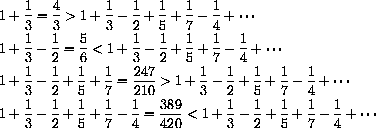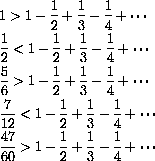
Dirichlet's theorem 13.4 from the Mathematical Background book (on the CD) gives us the convergent expression



We emphasized absolute uniform convergence in the main text, because that kind of convergence allows us to treat series the most like very long sums.
This section shows you an example of the strange nature of series that do not converge absolutely.
Actually, we could expand on the specific idea and show that for any number r or
 , we can rearrange the terms of a conditionally convergent series so that it sums to r. By rearranging terms, we can get any sum we choose! (The proof of this is not very hard, but it is more abstract than the specific example we give.)
, we can rearrange the terms of a conditionally convergent series so that it sums to r. By rearranging terms, we can get any sum we choose! (The proof of this is not very hard, but it is more abstract than the specific example we give.)
We showed in Example 27.1 of the main text that

 , since the approximating sums alternate up and down with decreasing size oscillations.
However, we want you to observe that rearranging these same terms results in a different limit, specifically,
PROVE THAT:
, since the approximating sums alternate up and down with decreasing size oscillations.
However, we want you to observe that rearranging these same terms results in a different limit, specifically,
PROVE THAT: 

 produce decreasing oscillations, that is,
produce decreasing oscillations, that is,






 .)
.)
You are welcome to use the symbolic summation of the computer. For example, to compare these series with Mathematica, you could type the program:
T := Sum[(1/(4 k - 3) + 1/(4 k - 1) - 1/(2 k) ,{k , 1, n}] ; S := Sum[1/(2 j - 1) - 1/(2 j) , { j , 1, n}] ; Do[ Print["T = " , T , "S = " , S , "n = " , n, "Diff approx =", N[T - S]],{ n , 1, 10 } ]